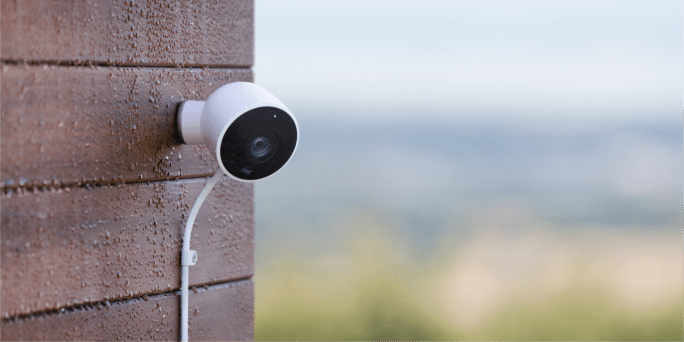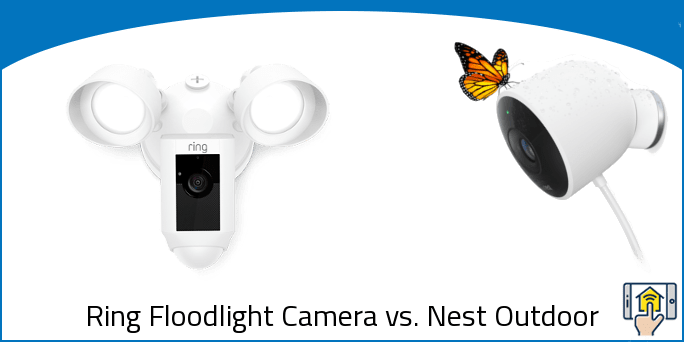Ring and Nest are two major names in the smart technology scene, and the Ring Floodlight Camera and provide some of the best video monitoring around. When comparing the two devices side by side, the Nest is the clear winner for homeowners looking for CVR (Continuous Video Recording); otherwise, the Ring may be the better buy.
While it’s helpful to compare Ring Floodlight Camera vs. Nest Outdoor on the cameras’ own merits, there’s something to be said for taking a look at their product ecosystems as well. Both brands have an impressive lineup of complementary smart devices covering everything from doorbells to home security. These two cameras both have their own benefits to bring to the table, so you should consider how you’d like to expand your smart home in the future as well.
Below we go into detail on the differences between the Ring Floodlight Camera and Nest Outdoor. Read on for a comprehensive review, or use our navigation bar to jump directly to the sections that interest you most.
Ring Floodlight Camera vs. Nest Outdoor — Differences
Difference #1: Field of View – Camera resolution does make a significant difference in the quality of your footage, but that quality can go to waste if the field of view isn’t wide enough to get all of the action within the frame. Field of view is the first major difference when comparing the Ring Floodlight Camera vs. Nest Outdoor, with the Ring being a good deal more impressive with 160° diagonal when compared to the Nest’s 130° diagonal.
Difference #2: Advanced Motion Detection – Both brands offer quality motion detection, but they differ in how you access those features.
The Ring Floodlight camera includes motion zones free of charge, which allows you to adjust the sensitivity of specific areas within your camera’s field of view in order to better protect the areas you’re worried about and reduce the incidence of false alarms. Furthering the motion detection’s accuracy is person detection, which allows your camera to pretty reliably distinguish between a human and unrelated motion from animals and cars.
The camera also uses an advanced motion detection setup that primarily uses the camera to detect activity rather than heat signatures. This further reduces the incidence of false alarms and makes for a more fully-featured detection setup overall.
Motion detection with the Floodlight Camera uses PIR sensors to trigger the lights when activity happens, at which point the camera will determine whether that motion actually represents a legitimate threat.
Nest’s motion detection also offers Motion Zones and Person Detection with one major caveat: the features are locked behind the Nest Aware subscription.
While the two brands offer similar features, it’s obviously a lot more convenient to have those features enabled by default rather than having to pay an ongoing monthly fee just to access the full extent of the camera’s capabilities.
Difference #3: Night Vision – Currently, both cameras offer black & white night vision using infrared LEDs. However, Ring will add in “Enhanced” night vision in the future that can actually record in color.
When this feature is enabled, Ring will be the clear winner when it comes to recording at night. The Nest Outdoor does provide a crisp picture using 8, 850 no LEDs enhanced by an IR cut-off filter, but having full-color footage can make it much easier to distinguish details in the event of a crisis.
Difference #4: Internet Connection – One area where the Nest Outdoor does pull ahead by a significant margin is in the way that it handles internet connections. As a dual-band device that can communicate using both the 2.4 GHz and 5GHz WiFi frequencies, the Nest Outdoor will put significantly less strain on your network when compared to the Ring camera that can only use the 2.4GHz band.
Difference #5: Siren – Being able to detect motion and provide timely alerts is the primary goal of these smart cameras, but the Ring Floodlight Camera can alert you audibly as well with a 110 dB siren built directly into the camera. With the ability to bring attention to an invasion and scare off potential intruders, it’s clear that the Ring has an advantage over Nest — especially when it comes to nighttime coverage when you’ll likely be asleep and unable to hear a phone notification.
Difference #6: Cloud Storage & Subscription – Checking in on your camera’s live view from time to time is great for keeping an eye on your home, but it’s the motion-triggered recordings that can record valuable evidence and shoulder the vast majority of your monitoring needs. With both the Ring and Nest cameras, those recordings are uploaded to the cloud, and the two brands differ in the way that they approach storage and subscriptions.
The Ring subscription is known as “Ring Protect,” broken into two tiers: Basic and Plus.
Ring Protect Basic covers a single device at $3 per month, and includes video recording and sharing for up to 60 days — allowing you to review footage whenever you please during that time period.
Ring Protect Plus costs $10 per month, but it will cover all devices within your home. In addition to that wide coverage and the 60 days of storage, you’ll have access to additional features like 24/7 professional monitoring and cellular backup if you’re using the Ring Alarm system.
The Nest Outdoor offers a 3-hour snapshot history for free, but if you want storage and features beyond that you’ll have to pay for the “Nest Aware” subscription. Nest Aware is broken into three different tiers, all named after the amount of video history they offer. 5-day is available for $5/month or $50/year, 10-day for $10/month or $100/year, and 30-day for $30/month or $300/year. The three plans are identical in what they offer outside of the amount of storage.
Speaking of what they offer, Nest Aware unlocks access to features like Cloud Activity Zones and Person Detection for more accurate monitoring and fewer false alarms. More importantly, however, is the 24/7 continuous video recording across all of your cameras. CVR is definitely not a standard feature on most cameras, and the brands that do offer it often charge a high fee on a per-camera basis. The CVR is one of the main reasons why the Nest Aware subscription is so great.
Simply put, the Ring Floodlight Camera is an excellent option for those looking for a lower monthly fee, but it’s really difficult to beat the low-cost CVR that Nest Aware provides.
Difference #7: LED Lights – One of the most obvious differences that separates the Ring Floodlight Camera from the Nest Outdoor is its 1800 Lumen floodlights. These lights are controlled by the PIR sensors and will activate when motion is detected, shedding light on any activity in your yard even after the sun goes down.
The Nest Outdoor has an RGB LED ring around the camera, but it’s only decorative and doesn’t really add any extra utility.
If you’re looking for that illumination factor, you’re probably going to be better off with the Ring camera since it combines the monitoring and floodlight in one convenient device.
Difference #8: Google Assistant – Since Ring is owned by Amazon, you’ll enjoy great integration with Amazon Alexa products. What you won’t see, however, is integration with Google Assistant, which isn’t exactly surprising since they are a direct competitor to Amazon. Although it might be understandable, it’s still disappointing for consumers who prefer Google voice control to Amazon.
With the Nest Outdoor, you will have access to Google Assistant and can even view your live feed using the Google Hub!
Difference #9: Operating Temperature – The Nest Outdoor camera can operate in a decently wide range of climates, with an operating temperature of –4° to 104°F, but it still pales in comparison to the impressive -22°F to 120°F. For those in areas with extreme temperatures on either end of the spectrum, the Ring Floodlight Camera might be the safer choice.
Ring Floodlight Camera vs. Nest Outdoor — Comparison Chart
| Ring Floodlight | ||
|---|---|---|
| Video resolution | 1080p | 1080p |
| Frames per Second | 30 FPS | 30 FPS |
| Video Format | H.264 | H.264 |
| On-Demand Live View | Yes | Yes |
| Record Live View | Subscription Required | with Nest Aware |
| Field of View | 140° | 130° diagonal |
| Zoom | Yes | 8x digital zoom |
| Power | Hardwired 110-240 VAC | AC |
| Optional Power Source | N/A | N/A |
| Battery Life | N/A | N/A |
| Two-Way Audio | Yes | Yes |
| Motion Detection | Advanced | Yes |
| Motion Zones | Custom, up to 6 | with Nest Aware |
| Person Detection | Yes | with Nest Aware |
| Facial Recognition | No | No |
| Sound Detection | Yes | Yes |
| Night Vision | Yes (enhanced coming) | 8 Infrared LEDs 850 nm LEDs: illuminates up to 25 feet IR cut-off filter |
| Internet Connection | WiFi: 2.4 GHz | WiFi: 2.4GHz or 5GHz |
| Requires a Base Station | No | No |
| Siren | 110 dB built-into camera | No |
| 24/7 Recording | No | with Nest Aware |
| Local Backup Storage | No | No |
| Cloud Storage | Subscription Required | 3-hour snapshot history or with Nest Aware |
| Review, Share, & Save | Subscription Required | with Nest Aware |
| Instant App Alerts | Yes | Yes |
| App Support | Android, iOS, Web | Android, iOS, Web |
| Rich Notifications | No | Yes, with a snapshot |
| Weather-resistant | Yes | Yes (IP65 rating) |
| LED Lights | Built-in floodlights | RGB LED |
| Amazon Alexa | Echo Show, Echo Spot | Echo Show, Echo Spot |
| Google Assistant | No | Yes |
| Google Home Hub | No | Yes |
| IFTTT | Yes | Yes |
| Stringify | Yes | Yes |
| Operating Temperature | -22°F to 120°F | –4° to 104°F (–20° to 40°C) |
| Dimension | Base: 4.75-inch diameter | 2.8 x 3.5 in. |
| Color | Black/White | White |
Ring Floodlight Camera vs. Nest Outdoor — Things in Common

Video Quality – All the useful features in the world won’t make much of a difference in the camera can’t record quality video. Fortunately, both the Ring and Nest cameras record in 1080p at a smooth 30FPS which ensures crisp, clear footage. Additionally, the streams with both models feature H.264 video compression, which ensures allows for recordings that maintain high quality without clogging up your network.
Live View – Access your camera’s video stream whenever you please with on-demand live view. You can also record that live view as well, but both brands require that you purchase a subscription to access that specific feature.
Zoom – Focus on the details with zoom functionality featured on both cameras.
Two-Way Audio – In addition to the audio that accompanies your video recordings, you’ll also be able to speak directly through the camera using the two-way audio feature. It’s great for scaring off a pesky package thief, or even just for scolding your cat off the counter while you’re checking in on your home while away at work.
App Support – Regardless of your choice in brand, you’ll be able to access and control your cameras from an Android or iOS app as well as through a web portal. While most smart cameras feature smartphone support, it isn’t as common to see the ability to access the cameras through a desktop or laptop so that’s always a nice touch.
Smart Home Integration – Smart Home Integration is similar with both Nest and Ring, with support for Amazon Alexa as well as powerful conditional trigger systems like IFTTT and Stringify. By hooking your smart camera up to other smart devices, This gives you the ability to do things like cause motion detection to flash the lights to draw attention to a potential threat.
Ring Floodlight Camera vs. Nest Outdoor — Accessories

Both cameras provide pretty comprehensive home monitoring, so there aren’t too many accessories to recommend.
However, you may be interested in Ring Camera Installation if you don’t feel comfortable setting things up on your own. Just keep in mind that you’ll need existing wiring in order to take advantage of the service.
For the Nest Outdoor, we recommend adding a little extra flair to your camera with one of these Colorful Silicone Skins.
Ring Floodlight Camera vs. Nest Outdoor — Our Thoughts

Our recommendation for the camera to buy when comparing the Ring Floodlight Camera vs. Nest Outdoor is really going to depend on the type of features you’re looking for.
If you’re interested in the utility that Continuous Video Recording has to offer, the is the clear choice. However, if that isn’t as important to you we feel that the Ring Floodlight has the edge due to better overall camera specifications.
A smart camera for monitoring the exterior of your home can be further enhanced with a smart doorbell — adding extra convenience and security to your entryway. Check out or take on the Nest Hello vs. Ring Pro, because the features that those products have to offer might influence your decision. Nest also offers the Nest x Yale smart lock, which Ring can’t really match.
At the end of the day, the best choice is going to depend on the features you value, your choice of voice assistant, and the larger product families of each brand.
For more information about other cameras, check out our detailed comparison:
- eufy Floodlight Camera vs. Ring Floodlight Cam
- Ring Spotlight vs. Floodlight
- Arlo Pro vs. Ring Floodlight Cam
- Nest Cam IQ Outdoor vs. Nest Cam Outdoor
Last update on 2024-04-18 at 20:12 / Affiliate links / Images from Amazon Product Advertising API




